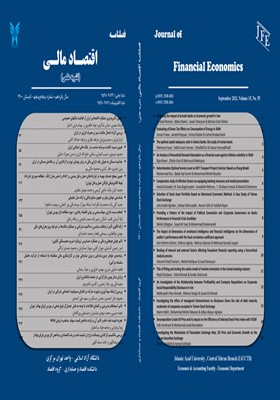بررسی اثرات اعمال مالیات سبز بر مصرف انرژی در ایران Evaluating of Green Tax Effects on Consumption of Energy in IRAN
محورهای موضوعی : اقتصاد مالی
فرناز فروتن
1
![]() ,
جمشید پژویان
2
*
,
فرهاد غفاری
3
,
فرهاد خداداد کاشی
4
,
جمشید پژویان
2
*
,
فرهاد غفاری
3
,
فرهاد خداداد کاشی
4
1 - گروه اقتصاد، واحد علوم تحقیقات، دانشگاه آزاد اسلامی، تهران، ایران
2 - گروه اقتصاد،، واحد علوم تحقیقات، دانشگاه آزاد اسلامی، تهران، ایران
3 - گروه اقتصاد، واحد علوم تحقیقات، دانشگاه آزاد اسلامی، تهران، ایران
4 - عضو هیأت علمی دانشگاه پیام نور
کلید واژه: مالیات سبز, H23, : سیستم تقاضا, کشش قیمتی. طبقه بندی JEL : D12,
چکیده مقاله :
حمل و نقل و سایر کالاهای بی دوام را به تفکیک سه طبقه فقیر، متوسط و ثروتمند جامعه طی سال های 1396-1383 بررسی می کند. برای این منظور کشش های قیمتی جبرانی و غیر جبرانی تقاضا و نیز کشش های درآمدی گروه کالاهای مذکور از طریق سیستم تقاضای تقریباً ایده آل غیر خطی برآورد شده است. نتایج حاکی از آن است که، علامت کشش های قیمتی خودی بر اساس انتظار نظری مورد تأیید می باشند. ضمن این که دو گروه انرژی خانگی و سوخت حمل و نقل از نظر قیمتی برای هر سه سطح درآمدی تقریباً باکشش ظاهر شده اند. در واقع افزایش قیمت یک درصدی انرژی خانگی در صورتی که با جبران مصرفکننده همراه نباشد، منجر به کاهش حدود یک درصد مصرف انرژی در همه خانوارها و نیز کاهش 002/0 درصد مصرف سوخت خانوارهای متوسط خواهد شد. این نتیجه در مورد گروه سوخت حمل و نقل نیز صدق می کند. افزایش قیمت یک درصدی در گروه سوخت، بدون جبران مصرف کننده، منجر به کاهش 1 تا 005/1 درصد مصرف سوخت در همه خانوارها و همچنین کاهش درصد جزئی در مصرف انرژی در خانوارهای متوسط و ثروتمند خواهد شد. گروه کالایی سوخت های حمل و نقل برای گروه فقیر و متوسط جامعه به صورت کالای لوکس و برای گروه ثروتمند به صورت کالای ضروری و گروه انرژی خانگی برای تمام خانوارها به صورت کالای ضروری ظاهر شده است.Evaluating of Green Tax Effects on Consumption of Energy in IRAN Farnaz FrotanJamshid PajoyanFarhad GhafariFarhad Khodad KashiThis dissertation evaluates the effects of taxing on three groups of goods, i.e. housing energy, transport fuels, and other non-durable goods in rich, moderate and poor households during the period of 2004-2017. To this end, we compute the income and price elasticities respect to each categories of goods by the estimates obtained for the parameters of a Quadratic Almost Ideal Demand System. According to the results, while the sign of the own price elasticities is theoretically expected, the groups of housing energy and transport fuels appear to be elastic in every three type of households. One percent Increasing in the price of housing energy, if the consumer isn’t compensated, results in about 1 percent decrease in energy consumption in all households and also 0.002 percent reduction in fuel consumption in moderate households. There are the same results for the group of transport fuel. One percent increasing in the price of transport fuel, without compensation of consumer, results in about 1 percent decrease in energy consumption in all households and also a partial reduction in energy consumption of rich and moderate households. As well as housing energy category has appeared as a necessity in all three types of households and transport fuel category has appeared as luxury for poor and moderate, and a necessity for the rich households.
This dissertation evaluates the effects of taxing on three groups of goods, i.e. housing energy, transport fuels, and other non-durable goods in rich, moderate and poor households during the period of 2004-2017. To this end, we compute the income and price elasticities respect to each categories of goods by the estimates obtained for the parameters of a Quadratic Almost Ideal Demand System. According to the results, while the sign of the own price elasticities is theoretically expected, the groups of housing energy and transport fuels appear to be elastic in every three type of households. One percent Increasing in the price of housing energy, if the consumer isn’t compensated, results in about 1 percent decrease in energy consumption in all households and also 0.002 percent reduction in fuel consumption in moderate households. There are the same results for the group of transport fuel. One percent increasing in the price of transport fuel, without compensation of consumer, results in about 1 percent decrease in energy consumption in all households and also a partial reduction in energy consumption of rich and moderate households. As well as housing energy category has appeared as a necessity in all three types of households and transport fuel category has appeared as luxury for poor and moderate, and a necessity for the rich households.
یادداشتها
_||_

